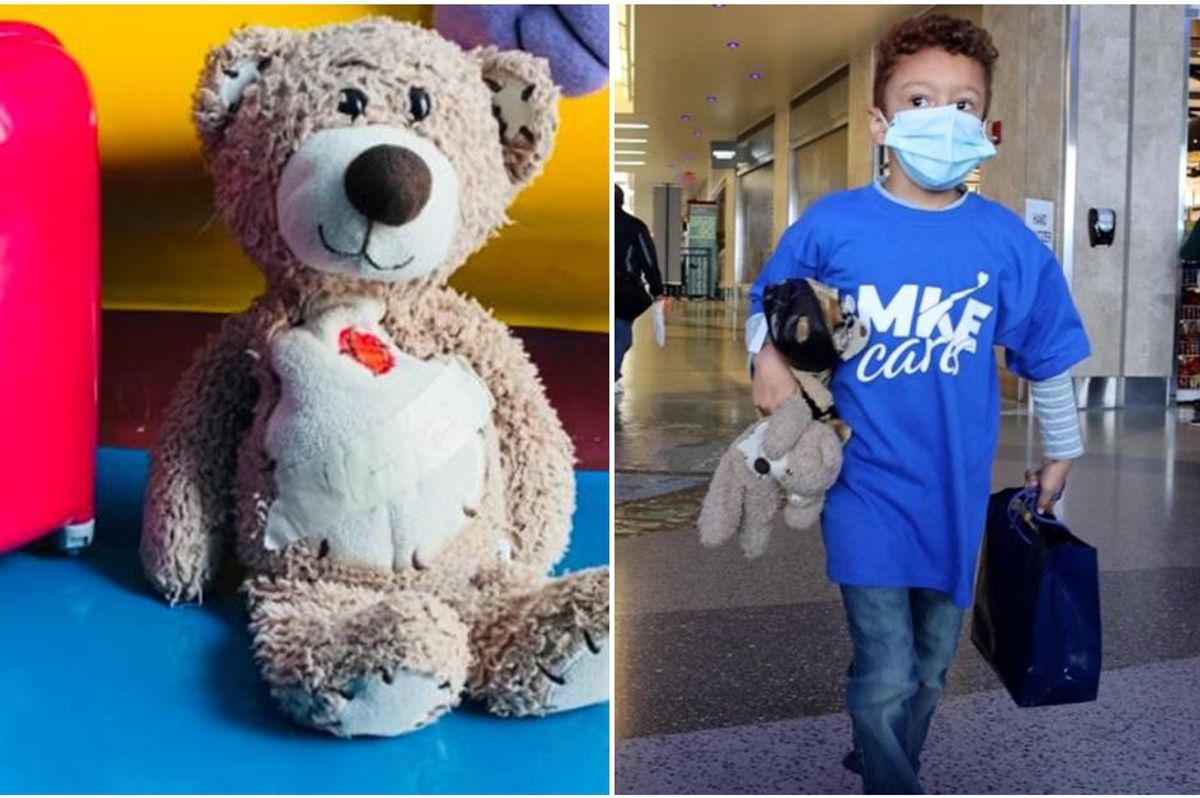
Original Teddy was lost and found by his friend Ezekiel.
For a 5-year-old to lose their teddy bear is akin to the death of a family member or a pet. Children become attached because they truly believe their stuffed animals have an innate life force.
That’s why when a child loses their attachment object, it can be impossible to replace, even if the parents find something that’s identical.
"If there was a machine which copied a favorite object in every way down to atomic level, we would still prefer the original. It has an essence to it,” psychologist Bruce Hood told The Guardian. "We anthropomorphize objects, look at them almost as if they have feelings. The children know these objects are not alive but they believe in them as if they are."
That’s why 5-year-old Ezekiel Burnett was devastated after losing his teddy bear, aka “Original Teddy” at Milwaukee Airport last November. He was boarding a plane with his parents when he threw it up in the air on the concourse and it got stuck in the rafters.
Recognize this face? The search for bear's owner continues! Thank you for helping us spread the word and to those who pointed out that this bear likely belongs to a kid born with CHD. How special he must be. Let's get him home!pic.twitter.com/hCZc4RhF0P— MKE - Milwaukee Airport (@MKE - Milwaukee Airport) 1644266791
The family didn’t have time to stop and retrieve the bear for fear of missing their flight. So Original Teddy was left behind.
“He’s had this bear since day one and slept with it every night. It has a lot of sentimental value to him,” his dad, David Burnett, recounted. “When we got back home he literally cried the whole flight and was still upset. So, it’s really special to him.”
In January, the bear was found and returned to the airport’s information desk and it put out several tweets searching for Original Teddy’s family. A post featuring the bear went viral and was seen more than 4 million times.
Earlier this month, David Burnett and his wife were watching “Survivor” on TV when she nearly jumped out of her chair like "she won the lottery" after seeing a video of the bear shared by a friend on Facebook. “She couldn't even speak,” he later recalled.
The family got in touch with the airport and it shared the good news on Twitter.
Update: Thank you all so much! We found the owner and we are working out the details for their reunion! Stay tuned! pic.twitter.com/EgZSzXRJ9z
— MKE - Milwaukee Airport (@MitchellAirport) February 9, 2022
This type of bear resonated with many of the people who shared the video and tweets because it has a heart on its chest with stitches. These bears have been given to children born with congenital heart defects. Ezekial was born with a healthy heart and was given the bear as a gift from a friend of the family.
Teddy and 5-year-old Ezekiel have been REUNITED! Thank you @SouthwestAir and the 4 million people across the globe who followed along on Teddy's journey. We're so glad he's home!pic.twitter.com/UWv9cI7m8G— MKE - Milwaukee Airport (@MKE - Milwaukee Airport) 1644954632
Southwest Airlines was kind enough to fly the family from their home in Texas back to Milwaukee to retrieve the bear at a ceremony in one of its terminals.
“We’re very honored to be a part of this special moment,” Airport Director Brian Dranzik said. “Small moments like this, along with the bigger ones, are why we support our hometown airport.”
David Burnett said that his son was overjoyed that the bear had been found and can’t quite understand the “magnitude” of the event, “but has been talking about it every single day.”
At the ceremony, Ezekiel and Original Teddy were reunited and hopefully, this time, it’s forever.
- 17 totally true facts about black bears that'll bring the warm and ... ›
- Woman turns old clothes of lost loved ones into memory bears so ... ›
- Dad brought to tears after receiving a teddy bear with his late ... ›

